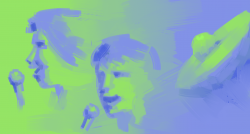This month, Georgetown University Pride is organizing a week of programming themed issues as well as issues of gender norms and expectations. But why is specific programming necessary for these groups when everything that Pride does is meant to apply to the entire LGBTQ community, which clearly includes the ‘T’?
There are examples of why this is necessary everywhere in the queer world—perhaps and, perhaps most notably in the form of the Employment Nondiscrimination Act that recently passed in Congress with the blessing of the Human Rights Campaign, the nations largest LGBT civil rights organization. The act is meant to protect against bias in the work place, but the provisions on sexual orientation (that would have done the same for gender identity and expression) were removed .
GU Pride is trying to correct past injustices and contemporary failures, at least in our microcosm of the far greater movement, by using this week as the beginning of a serious push to build a Georgetown community that is more inclusive of sexual and gender minorities and allies representing not only all queer identities, but also of diverse racial, ethnic, religious, and socio-economic backgrounds.
I grew up on the back of a small mountain outside of Chattanooga, Tennessee and attended six years of all-male Christian school, during four of which I was open about my homosexuality. The picture that this may evoke in terms of the bigotry I faced is more extreme than my actual experience. I come from an exceedingly supportive home and always surrounded myself with socially liberal people, and find that geography actually plays less a role than one might think. My city and school situations posed problems for me as a homosexual male, but I never witnessed hate violence of the caliber we have seen on this campus this semester. The important thing about what I did go through before coming here, though, is that I have not been discriminated against and hated because of my sexuality, but rather because of my femininity—though the two have been unfairly conflated by many an aggressor.
What I do in the privacy of my bedroom is of little concern to most people. The real issue lies in how uncomfortable it makes people that I, along with countless others, do not fit neatly into the box labeled “man” and exhibit all the behavioral expectations that go along with it, which is, ultimately, a more minor version of the identical problem faced by the transgender community.
I find it is ridiculous when activists on both sides of the line call for a split between these two causes. As if it weren’t enough that a man loving another man is, in its base, a transgression of gender roles, a substantial group within the transgender population identifies sexually as other than straight (from bisexual transmen, natural born females who identify as men, to butch women who live complex lives between transmen and lesbianism) and a substantial portion of sexually queer people exhibit examples of gender non-normativity (from screaming queens to androgynous lesbians and cute, spunky gay boiz).
The problem arises from people’s assumptions of the lines that divide us. Heterosexual cross-dressing men worry that people will believe them to be gay; transsexuals fret that genderqueers playing with their expression will cause people to take their largely static identity less seriously; gender-normative homosexuals often feel held down by stereotypes of butch lesbianism and femme homosexuality. The goal of this week is to emphasize the importance of engaging with individuals and emphasizing who they feel they are over how they are perceived.
Gender theorists Gordene MacKenzie and Paisley Currah describe the term ‘transgender’ as referring to a “gender galaxy.” So do all of us represent specific interactions of the various elements of our identities, and only through exploring those can we begin to get a clearer picture of who we are.




